
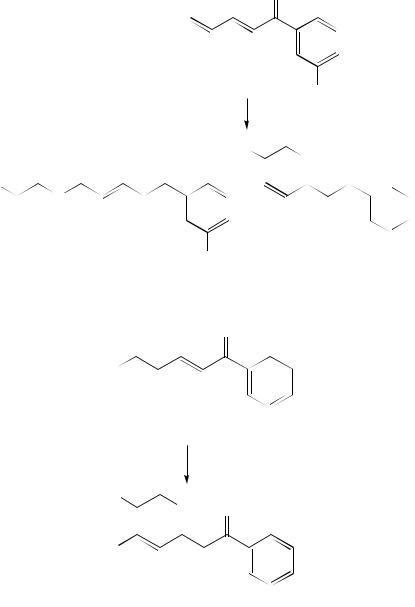
8. Nucleophilic additions to dienes, enynes and polyenes |
665 |
into the 1,6-adduct by treatment with diisopropylethylamine. Introduction of a sterically demanding substituent, e.g. a phenyl group, at C-5 of the dienone, prevents the formation of the 1,6-addition product even in the absence of a Lewis acid (equation 43)123.
O
NO2
Base HSCH2CH2OH
O |
HO |
S |
(42) |
|||||||
|
O |
|||||||||
HO |
|
|
|
|
|
|
|
|
|
|
|
|
|
|
|
|
|
|
|
|
|
S |
|
|
|
+ |
|
|
|
|
||
|
|
|
|
|
|
|
||||
|
|
|
|
|
|
|
|
|
|
|
|
|
|
|
NO2 |
|
|
|
|
|
NO2 |
|
|
|
|
|
|
|
|
|
||
|
|
45 °C: |
>99 : <1 |
|
|
|
|
|||
|
|
−40 °C: |
40 |
: 60 |
|
|
|
|
||
TiCl4, −40 °C: |
<1 : >99 |
|
|
|
|
|||||
O
Ph
NO2
i-Pr2NEt HSCH2CH2OH
(43)
HO
S O
Ph
NO2
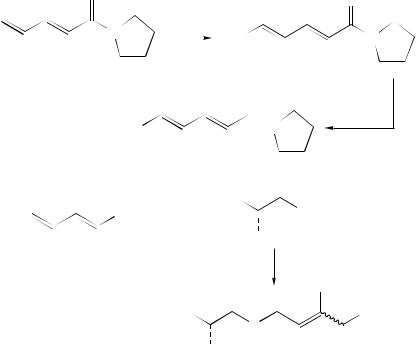
666 |
Norbert Krause and Claudia Zelder |
Regioselective 1,6-addition reactions of sulfur nucleophiles to activated dienes were utilized by several groups for the synthesis of biologically relevant target molecules125 – 128. Najera´ and coworkers125 prepared several 5-tosyl-2,4-pentadienamides by 1,6-addition of sodium 4-toluenesulfinate to 2,4-pentadienamides, iodination and spontaneous dehydroiodination (equation 44). These transformations took place with complete control of the configuration of the olefinic double bonds. The products underwent 1,6-addition/elimination reactions with carbon and sulfur nucleophiles; with benzylthiolate, a double 1,6-addition could be realized. Treatment of the pyrrolidinyl derivative with pentylmagnesium chloride led directly to the natural product sarmentine, again with retention of the configuration of the double bonds. The 1,6-addition products of L-cysteine and various derivatives of this amino acid to trifluoroethyl 2-propyl-2,4-pentadienoate were prepared and identified as possible metabolites of the anticonvulsant agent valproic acid (2-propylpentanoic acid; equation 45)126.
O
|
|
O |
||||||
N |
PhSO2Na |
|
|
|
|
|
|
|
|
|
|||||||
|
|
PhS |
||||||
|
|
|||||||
|
I2 |
|
|
|
|
|
|
|
|
|
|
||||||
|
|
O |
||||||
|
|
|
|
|
|
O |
||
n-C5H11 |
|
|
|
|
|
|
|
N |
|
|
|
|
|
|
|
||
|
Sarmentine |
|||||||
n-Pr
HO2C
CO2CH2CF3 +
NHAc
HO2C
S
NHAc
O
N
(44)
n-C5H11MgCl
SH
(45)
n-Pr
CO2H
Structurally rather complicated target molecules can be synthesized with the aid of thiolate 1,6-addition reactions to acceptor-substituted dienes as well. For example, a richly functionalized proline derivative with a 2,4-pentadienal side chain was converted into the corresponding 6-phenylthio-3-hexen-2-one derivative by 1,6-addition of phenylthiolate, treatment of the adduct with methyl lithium and oxidation (equation 46)127. The product was transformed into acromelic acid A, the toxic principle of clitocybe acromelalga ichimura. Similarly, the 1,6-addition reaction of cesium triphenylmethylthiolate to methyl 2,4-pentadienoate served for the construction of the disulfide bridge of the macrobicyclic antitumor depsipeptide FR-901,228128.
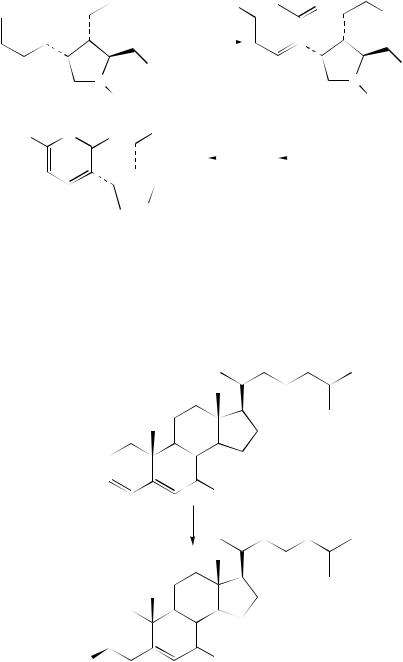
|
|
|
8. Nucleophilic additions to dienes, enynes and polyenes |
667 |
|||||||
|
|
|
|
|
|
PhS |
O |
OTBS |
|||
|
|
CHO |
|
OTBS |
|
|
|||||
|
|
|
|
|
|||||||
|
|
|
|
|
|
|
|
|
|
|
|
|
|
|
|
|
1. PhSH, Et3N |
|
|
|
|||
|
|
|
|
|
|
|
|
|
|
|
|
|
|
|
|
|
2. MeLi |
|
|
|
|||
|
|
|
|
OTBS 3. PDC |
|
N |
OTBS |
||||
|
|
|
N |
|
|
|
|
|
|
|
|
|
|
|
Boc |
|
|
Boc |
|||||
|
|
H |
|
CO2H |
|
|
(46) |
||||
|
|
|
|
|
|||||||
|
|
|
|
|
|
||||||
HO2C |
N |
O |
|
|
|
||||||
|
|
|
|
|
|
|
|
|
|
|
|
 CO2H
CO2H
 N
N
H
Acromelic acid A
The first 1,6-addition reactions of thiolates to steroid dienones were examined well before the discovery of the antiestrogenic properties of 7˛-substituted steroids. Ralls and coworkers129 and Djerassi and coworkers130 studied thiol additions to 3,5-steroids; for example, the reaction of 3,5-cholestadien-7-one with ethanethiol was reported to proceed with high 1,6-regioselectivity and ˇ-stereoselectivity (equation 47)129. In a series of papers, Brueggemeier and coworkers131 – 137 described the synthesis and biochemical evaluation of numerous 7˛-sulfur-substituted steroids which were prepared by Michael addition to steroid dienones. Thus, 4,6-androsta-3,17-dienone was treated with various
O
(47)
EtSH
EtS |
O |
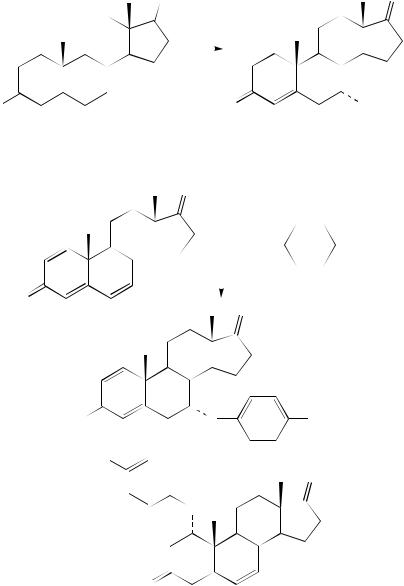
668 |
Norbert Krause and Claudia Zelder |
|
|||||
|
O |
O |
|||||
|
|
RSH |
|
||||
|
|
|
|
|
|
|
|
|
|
Na |
|
||||
|
|
|
|
|
|
|
(48) |
O |
|
|
|
O |
SR |
||
|
|
|
|
R = n-Bu: 58% |
|
||
|
|
|
|
Ph: 84% |
|
||
|
|
|
|
Bn: 98% |
|
||
|
|
|
|
4-H2NC6H4: 91% |
|
||
|
O |
|
|||||
|
|
|
+ HS |
NH2 |
|||
|
|
|
|
|
|
||
|
|
|
|
||||
|
O |
|
|||||
|
|
|
|
O |
|
||
(49)
O |
|
S |
|
NH2 |
|
+ |
|
|
|
|
|
|
||
|
H2N |
|
|
|
|
|
S |
|
O |
|
|
|
||
|
|
|
|
|
|
|
|
|
|
O
aliphatic and aromatic thiols to furnish the 7˛-substituted adducts with moderate to excellent yield (equation 48)131 –136. The analogous reaction of 1,4,6-steroids gave mixtures of 1,6-adducts and 1,4-addition products resulting from attack of the thiolate at
C-1 (equation 49)134,137. Subsequent functionalization provided steroids which were not directly accessible by 1,6-addition (equation 50)132,133,136.
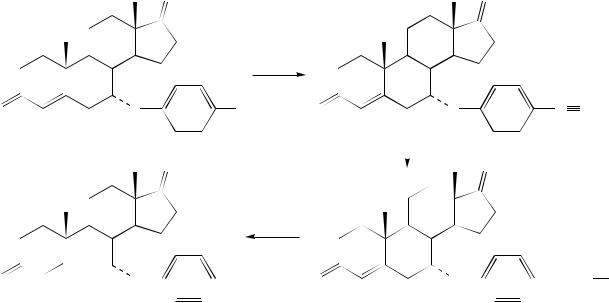
O O
NaNO2
HCl
|
|
|
|
|
|
|
|
+ |
||
O |
S |
|
|
NH2 |
O |
S |
|
|
N N |
|
|
|
|
|
|
|
|
|
|
|
|
|
|
|
|
|
|
Me2NH |
|
(50) |
||
|
|
O |
|
|
|
O |
||||
|
|
|
|
|
||||||
NaI
CF3CO2H
O 
 S
S
 I O S
I O S
 N
N N NMe2
N NMe2
669

670 |
Norbert Krause and Claudia Zelder |
III. ENYNES
A. Carbon Nucleophiles
As in the case of addition reactions of carbon nucleophiles to activated dienes (Section II.A), organocopper compounds are the reagents of choice for regioand stereoselective Michael additions to acceptor-substituted enynes. Substrates bearing an acceptor-substituted triple bond besides one or more conjugated double bonds react with organocuprates under 1,4-addition exclusively (equation 51)138 – 140; 1,6-addition reactions which would provide allenes after electrophilic capture were not observed (cf. Section IV).
CO2Me |
|
|
R |
|
|
|
|
|
CO2Me |
|
1. R2CuLi |
|
|
(51) |
|
|
|||
|
2. H+ |
|
|
|
|
|
|
|
|
R = Et, t-Bu, Me3Si
In contrast to these transformations, nucleophilic additions to enynes with an acceptor substituent at the double bond are highly rewarding from both the preparative and mechanistic point of view38,141. According to Scheme 2 (Section I), the outcome depends strongly on the regioselectivity of the nucleophilic attack and of the electrophilic trapping of the enolate formed. Recent investigations have demonstrated that the regioand stereoselectivity of both steps can be controlled by the choice of the reactants, in particular by ‘fine-tuning’ of the organocopper reagent and the electrophile. The first example was reported by Hulce142,143 who found that 3-alkynyl-2-cycloalkenones react with cuprates at the triple bond in a 1,6-addition and the allenyl enolate is protonated at C-4 with the formation of conjugated dienones as mixtures of E/Z-isomers (equation 52). As observed in other cuprate addition reactions138,139, the Z-stereoselectivity rises with increasing size of the group R3. Interestingly, substrates of this type can also undergo tandem 1,6-5,6- additions, indicating that the allenyl enolate formed by 1,6-cuprate addition is sufficiently electrophilic to react with another organometallic reagent in a carbometalation of the allenic double bond distal to the electron-releasing enolate moiety144. In this way, it is also possible to introduce two different groups at the terminus of the Michael acceptor, either by using two organometallic reagents successively or by employing a mixed cuprate (equation 53).
O |
O |
|
|
R1 |
|
R1 |
|
3 |
|
R2 |
|
1. R2CuLi • LiCN |
|
|
|
2. H+ |
|
|
(52) |
n |
n |
R3 |
 R2
R2
n = 1,2; R1 = H, Me; R2 = H, Ph, HMe3Si; R3 = Me, Et; i-Pr, n-Bu, t-Bu, Ph, CH
 CH2
CH2
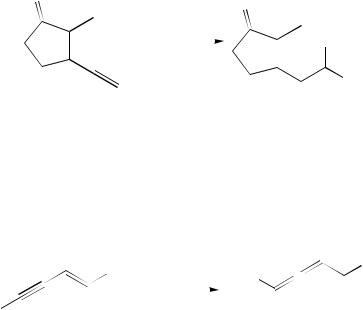
8. Nucleophilic additions to dienes, enynes and polyenes |
671 |
O |
O |
|
|||
|
|
|
|
||
|
|
MePhCuLi • LiCN |
|
Me |
(53) |
|
|
|
|||
|
|
|
|
||
|
|
|
|
||
|
|
|
|
|
Ph |
|
|
|
|
|
|
|
|
|
|
|
|
More interesting in preparative terms would be the possibility of shifting the regioselectivity of the electrophilic quenching reaction towards formation of allenes, since the number of synthetic methods for the preparation of functionalized allenes has been rather limited145. Furthermore, a stereoselective reaction of this type would open up a route to these axially chiral compounds in enantiomerically enriched or pure form. Indeed, the Gilman cuprate Me2CuLi ž LiI and cyanocuprates R2CuLi ž LiCN (R D6 Me) in diethyl ether react regioselectively with variously substituted 2-en-4-ynoates in a 1,6-fashion (equation 54). Protonation with dilute sulfuric acid gives the ˇ-allenic esters with alkyl, alkenyl, aryl and silyl substituents in good yield146.
CO2Et |
|
2 |
CO2Et |
|||
R |
• |
|||||
|
1. R22 CuLi |
|
|
|||
|
2. H+ |
|
|
|
||
R1 |
|
|
R1 |
|||
R1 = Ph, R2 = Me: |
|
|
(54) |
|||
|
|
79% |
||||
R1 = Ph, R2 = t-Bu: |
|
|
81% |
|||
R1 = n-Bu, R2 = Ph: |
|
62% |
||||
R1 = Me3Si, R2 = Me: |
57% |
|||||
The regioselectivity of the addition of organocuprates to acceptor-substituted enynes is hardly influenced by the nature of the acceptor substituent. Enynes containing ester, thioester, lactone and dioxanone as well as keto, sulfonyl, sulfinyl, cyano and oxazolidino groups react in a 1,6-manner to give the corresponding functionalized allenes (equation 55)146 – 148. Only 1-nitro-l-en-3-ynes are attacked at the CDC double bond with the formation of 1,4-adducts (equation 56)148. The differences in reactivity can be described qualitatively by the following reactivity scale: EWG D NO2 > COR, CO2R, COSR > CN, SO3R, oxazolidino > SO2R > SOR × CONR2. Remarkably, the regioselectivity of the cuprate addition to acceptor-substituted enynes is also insensitive to the steric properties of the substrate; enynes with t-butyl substituents at the triple bond undergo 1,6-addition, even when the cuprate itself is sterically demanding (equation 57)147. The reaction is therefore highly suitable for the preparation of sterically encumbered allenes.
In order to achieve acceptable yields with the less reactive Michael acceptors, it is often necessary to use more reactive organocopper reagents or Lewis acid catalysis. Thus, the reaction of (1-penten-3-yn-1-yl) phenyl sulfone with five equivalents of Me2CuLi alone gave no trace of addition product, whereas the analogous reaction with Me3CuLi2 provided the desired allene in 16% yield (equation 58)148. With two equivalents of Me2CuLi in the presence of one equivalent of Me3SiI the yield increased to 45%, while with added Me3SiOTf the allene was isolated in 29% yield. Only amides fail to form 1,6-adducts
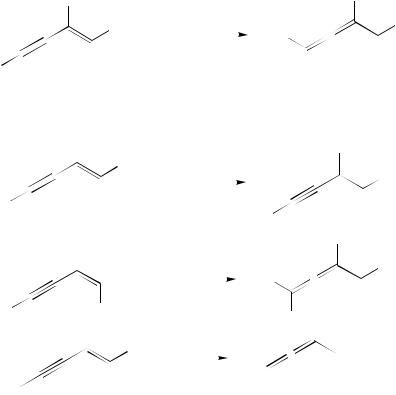
672 |
Norbert Krause and Claudia Zelder |
under these conditions. |
|
|
R |
R |
||
|
|
|||
|
EWG 1. t-Bu2CuLi • LiCN |
EWG |
||
|
• |
|||
|
|
|
Me |
|
|
|
|
||
|
|
2. H+ |
|
|
Me |
|
|
|
(55) |
|
|
t-Bu |
|
|
|
|
|
|
|
|
|
EWG = CN, R = Me: |
79% |
|
|
|
EWG = SO2Ph, R = H: |
91% |
|
|
|
EWG = SO3Et, R = H: |
49% |
|
|
|
|
|
|
|
|
|
t-Bu |
|
NO2 |
|
|
|
|
|
||
|
|
|
1. t-Bu2CuLi • LiCN |
NO2 |
||||
t-Bu |
|
|
2. H+ |
|
|
|
|
(56) |
|
|
|
|
|
|
t-Bu |
|
|
|
|
|
|
|
|
|
|
|
|
t-Bu |
|
|
|
|
t-Bu |
||
|
|
|
|
|
|
|||
|
|
1. t-Bu2CuLi • LiCN |
CO2Me |
|||||
|
|
|
|
|
|
|
t-Bu |
• |
|
|
2. H+ |
|
|
|
|||
|
|
|
|
|
|
(57) |
||
t-Bu |
CO2Me |
|
|
|
|
t-Bu |
||
|
|
|
|
|
|
|
|
|
|
SO2Ph |
Cuprate |
SO2Ph |
|||||
|
• |
|||||||
|
|
|
|
|
|
|
|
(58) |
|
Me2CuLi: |
0% |
||||||
|
Me3CuLi2: |
16% |
||||||
|
Me2CuLi / Me3SiI: |
45% |
||||||
|
Me2CuLi / Me3SiOTf: |
29% |
||||||
In contrast |
to the substrate, the |
organocuprate has |
a pronounced influence on |
|||||
the regioselectivity of the addition to acceptor-substituted enynes. While the Gilman cuprate Me2CuLi ž LiI and cyanocuprates R2CuLi ž LiCN (R 6D Me) add regioselectively in a 1,6-manner, the Yamamoto reagent RCu ž BF350 and the reagent combination RCu/Me3SiI149 lead to 1,4-adducts (equation 59)38,146. The behavior of the cyanocuprate s-Bu2CuLi ž LiCN towards 2-en-4-ynoates is particularly unusual since the reaction is very solvent-sensitive. In THF the 1,6-adduct is obtained as the major product, whereas in diethyl ether the 1,6-reduction product is the main component of the product mixture (equation 60)150. Other cyanocuprates of the stoichiometry R2CuLi ž LiCN react with acceptor-substituted enynes in THF very slowly under 1,6-addition or not at all38. A 1,6- reduction was also observed in the reaction of benzyl 3-methyl-2-penten-4-ynoate with Me2CuLi/n-Bu3P141. The reduction products may be formed by electron transfer from the cuprate or by hydrolysis of a stable copper(III) intermediate.

8. Nucleophilic additions to dienes, enynes and polyenes |
673 |
|||||
|
|
|
|
|
Me |
|
CO2Et |
|
1. MeCu / Me3SiI |
|
|
|
CO2Et |
|
|
|
|
|||
Ph |
|
2. H+ |
|
|
(59) |
|
|
|
|
Ph |
|
|
|
|
|
|
|
|
|
|
|
|
|
|
|
60% |
|
CO2Et |
|
|
|
t-Bu |
• |
CO2Et |
1. s-Bu2CuLi • LiCN |
|
|||||
|
|
|
|
|||
|
|
|
|
|
|
|
t-Bu |
2. H+ |
|
|
|
||
|
|
|
|
s-Bu |
|
|
|
|
|
|
|
|
|
|
|
|
|
|
+ |
(60) |
|
|
|
|
t-Bu |
• |
CO2Et |
|
|
|
|
|
||
|
|
|
|
|
H |
|
|
|
|
|
Solvent = THF: |
86 : 14 |
|
|
|
|
|
|
Et2O: |
15 : 85 |
So-called ‘lower order cyanocuprates’ RCu(CN)Li do not generally react with acceptor-substituted enynes. An exception is the cuprate t-BuCu(CN)Li which undergoes anti-Michael additions with 2-en-4-ynoates and nitriles (equation 61)151. The mechanistic aspects of this very unusual reaction are unknown; radical intermediates and electron transfer steps have not been found.
CO2Et
1. t-BuCu(CN)Li
2. H+
t-Bu
t-Bu |
• |
CO2Et |
|
||
|
t-Bu |
(61) |
|
|
|
|
H |
|
|
70% |
|
In analogy to copper-catalyzed 1,6-addition reactions of Grignard reagents to activated dienes (Section II.A), the 1,6-addition to acceptor-substituted enynes can also be conducted under catalytic conditions. However, only very carefully controlled reaction conditions lead to the 1,6-adduct as the major product, i.e. use of copper (2-dimethylami- nomethyl)thiophenolate as catalyst and simultaneous addition of the substrate and an organolithium reagent to a suspension of the catalyst in diethyl ether at 0 °C (equation 62)152. Under these conditions variously substituted ˇ-allenylcarboxylates are obtained with yields comparable to those of the stoichiometric cases. Other copper(I) salts and the use of Grignard reagents as the nucleophile led to very low yields of 1,6-addition products. A second catalytic version takes advantage of the fact that the products of the (stoichiometric) 1,6-cuprate addition, the lithium allenyl enolate and the organocopper compound are formed as independent species. The cuprate can be regenerated by addition of one equivalent of RLi such that it reacts with a further equivalent of the Michael acceptor. This procedure can, in principle, be repeated infinitely. The reaction is best conducted in a continuous mode by adding the substrate and the organolithium reagent
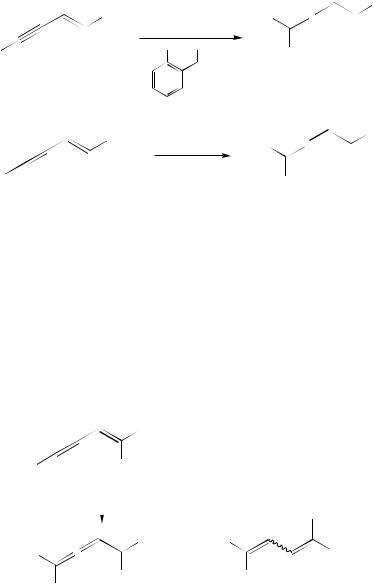
674 |
Norbert Krause and Claudia Zelder |
simultaneously to a solution of the cuprate (equation 63)38.
CO2Et
1. RLi, Et2O, 0°C
SCu NMe2
t-Bu
(cat.)
2. H+
CO2Et
1. RLi
R2CuLi (cat.)
t-Bu |
2. H+ |
CO2Et
t-Bu  •
•
R |
(62) |
R = Me: 64% n-Bu: 59% t-Bu: 83%
CO2Et
t-Bu  •
•
R |
(63) |
R = Me: 68% n-Bu: 83% t-Bu: 53%
As mentioned repeatedly, a precondition for the successful preparation of allenes by 1,6-addition is that the allenyl enolate reacts regioselectively with an electrophile at C-2 (or at the enolate oxygen atom to give an allenylketene acetal; see Scheme 2). The regioselectivity of the simplest trapping reaction, the protonation of the allenyl enolate, depends on the steric and electronic properties of the substrate and the proton source. Whereas the allenyl enolates obtained from 3-alkynyl-2-cycloalkenones always provide conjugated dienones by protonation at C-4 (possibly via allenyl enols; see equation 52)141 –143, ester enolates are usually protonated at C-2 (equation 54), in particular when sterically demanding groups at C-5 block the attack of a proton at C-4 (equation 57)38,146 – 148. However, with a substituent at C-2 of the enolate, mixtures of allenes and conjugated dienes are formed, since now protonation at C-2 is sterically hindered. In the case of ester enolates this problem can be solved by using weak organic acids as proton source (equation 64).
|
|
CO2Et |
|
|
|
Ph |
|
Me |
|
|
|
|
|
|
|
|
|
|
1. Me2CuLi |
2. X–H |
|
|
|
|
|
CO2Et |
|
Ph |
Me |
|
|
|
|||
|
|
|
(64) |
||
Ph |
• |
|
+ |
CO2Et |
|
|
|
Me |
|
Me |
|
|
|
|
|
||
|
Me |
|
|
|
|
|
X-H = 2N H2SO4, 25 °C: |
50 |
: 50 |
|
|
|
AcOH, 25 °C: |
64 |
: 36 |
|
|
|
t-BuCO2H, 25 °C: |
82 |
: 18 |
|
|
|
t-BuCO2H, –80 °C: > 99 |
: < 1 |
|
||
